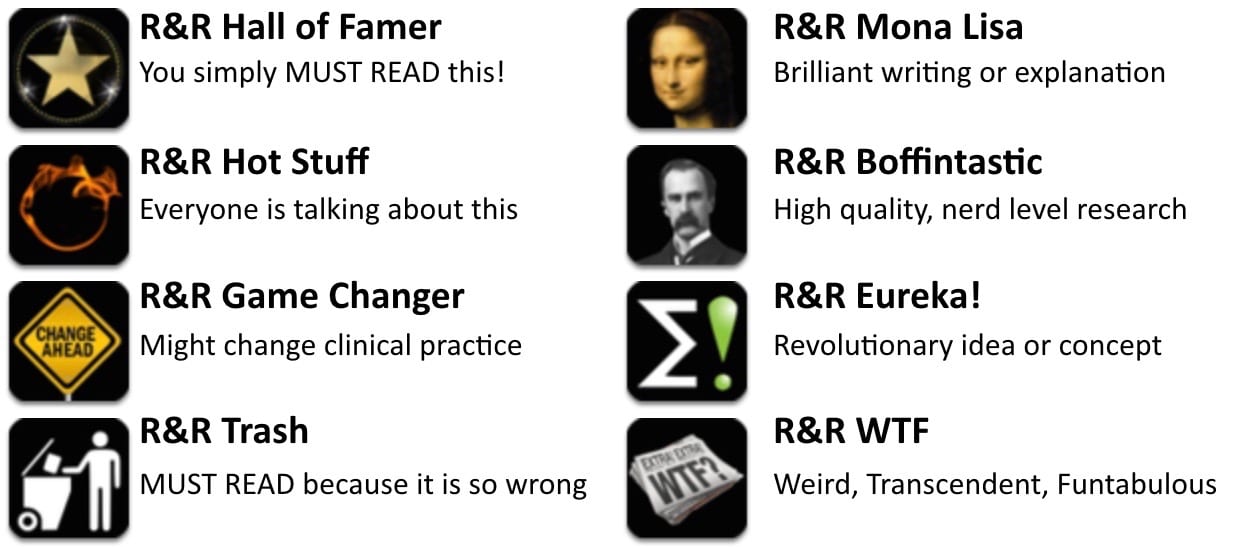R&R In The FASTLANE 068
Welcome to the 68th edition of Research and Reviews in the Fastlane. R&R in the Fastlane is a free resource that harnesses the power of social media to allow some of the best and brightest emergency medicine and critical care clinicians from all over the world tell us what they think is worth reading from the published literature.
This edition contains 6 recommended reads. The R&R Editorial Team includes Jeremy Fried, Nudrat Rashid, Soren Rudolph, Anand Swaminathan and, of course, Chris Nickson. Find more R&R in the Fastlane reviews in the : Overview; Archives and Contributors
This Edition’s R&R Hall of Famer
Cao D et al. Intravenous Lipid Emulsion in the Emergency Department: A Systematic Review of Recent Literature. J Emerg Med 2015. PMID: 25534900
- An excellent systematic review that aims to familiarize emergency care providers with the indications, dosing recommendations and common adverse reactions associated with Intralipid emulsion usage.The American Heart Association recommends use in local anesthetic systemic toxicity, and the American College of Medical Toxicology recommends consideration for circumstances of hemodynamic instability that results from lipid-soluble xenobiotics.
- Recommended by: Sa’ad Lahri
Bangalore S et al. Anticoagulant therapy during primary percutaneous coronary intervention for acute myocardial infarction:a meta-analysis of randomized trials in the era of stents and P2Y12 inhibitors. BMJ 2014. PMID: 25389143
- One size does not fit all when it comes to anticoagulant/antiplatelet therapy in acute MI. In this meta-analysis the authors found that the combination of LMWH and GIIb/IIIa inhibitors had the best outcomes in terms of MACE but bivalarudin was associated with less bleeding events. Each patient must be considered individually before an agent is selected.
- Recommended by: Anand Swaminathan
Calver L et al. Droperidol v. haloperidol for sedation of aggressive behaviour in acute mental health: randomised controlled trial. Br J Psychiatry 2014. PMID: 25395689
- Although not widely available, droperidol is often used for the management of agitated delirium. This paper compares droperidol (10mg IM) in 118 patients vs. haloperidol (10mg IM) in 100 patients. Appropriate sedation within 120 seconds occurred in 92% of patients without differences between agents. While sedation with droperidol required less rescue doses, it also had higher adverse events (5% vs 1%).
- Recommended by: Daniel Cabrera
Green SM et al. Ketofol for Procedural Sedation Revisited: Pro and Con. Ann Emerg Med2014. PMID: 25544732
- This editorial updates a 2011 iteration written by the same authors on the same topic, to reflect new studies on ketofol. These new studies again demonstrate that combining ketamine and propofol in the same syringe is safe and effective for procedural sedation. However, they also (again) demonstrate that the combination is not superior to propofol monotherapy. Ketofol advocates continue to point to theoretical advantages of the combination which have not been borne out in patient-oriented (or even physician-oriented) study endpoints. I recommend propofol monotherapy for brief procedures, especially when muscle relaxation is desired (e.g. cardioversion, joint reduction), and dissociative dose ketamine for longer procedures, with propofol available to use as needed for recovery agitation, muscle rigidity, or concerning hypertension.
- Recommended by: Reuben Strayer
Rising KL et al. Return Visits to the Emergency Department: The Patient Perspective. Ann Emerg Med 2014. PMID: 25193597
- Great qualitative look at where ED bouncebacks come from. There aren’t a lot of surprises here: poor followup options, ED as great one-stop shopping, and dissatisfaction with ED care (i.e. “they didn’t do anything!”). Not a lot of answers but we probably have some room to improve our communications on what we did for the patient and why they don’t need that CT.
- Recommended by: Seth Trueger
Noto MJ et al. Chlorhexidine Bathing and Health Care–Associated Infections: A Randomized Clinical Trial. JAMA 2015. PMID: 25602496
- Health care acquired infections remain a huge issue for critical care physicians contributing to increased mortality, increased hospital length of stay and increased costs. This large randomised cluster trial from the US did not support daily bathing of critically ill patients with Chlorhexidine as there was no reduction in the incidence of health care–associated infections including CLABSIs, CAUTIs, VAP, or C difficile. Unncessary exposure to Chlorhexidine may itself lead to the development of resistance to Chlorhexidine itself as well as increased costs associated with its use.
- Recommended by: Nudrat Rashid
Intensivist and Donation Medical Specialist, Australia | @NudratRashid |






